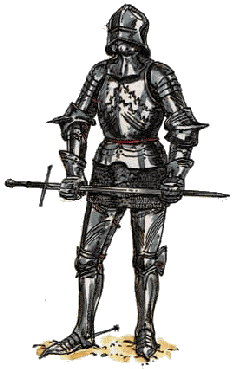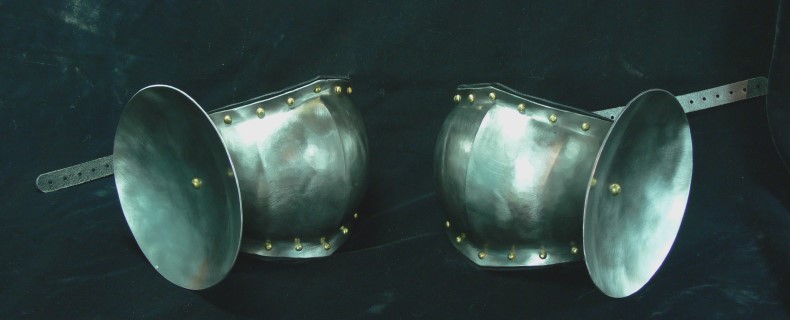Plate Mail (V7)
An Armor (V7)
According to the Rulebook (V7)
solid metal armor with riveted metal articulations to increase mobility. Example: Lorica Segmentata. This armor is worth a base of 6 Armor Points (V7).
History
Plate armor protecting the chest and the lower limbs was used by the ancient Greeks and Romans, but it fell into disuse after the collapse of the Roman Empire. Single plates of metal armour were again used from the late 13th century on, to protect joints and shins, and these were worn over a full mail haubergeon. By the end of the 14th century, larger and complete full plates of armour had been developed. During the early 1500s the helmet and neckguard design was reformed to produce the so-called Nürnberg armour, many of them masterpieces of workmanship and design. European leaders in armouring techniques were northern Italians and southern Germans. This led to the styles of Milanese from Milan, and Gothic from the Holy Roman Empire. Serbia produced armour in Novo Brdo and Kotor and England produced armour in Greenwich and they both developed their own unique style. Maximilian style armour immediately followed this, in the early 16th century. Maximilian armour was typically denoted by fluting and decorative etching, as opposed to the plainer finish on 15th century white armour. This era also saw the use of Close helms, as opposed to the 15th century style sallets and barbutes.
Full plate armour was very expensive to produce and remained therefore restricted to the upper strata of society, and lavishly decorated suits of armour remained the fashion with 18th century nobles and generals long after they had ceased to be militarily useful due to the introduction of rifling in the battlefield. Reduced plate armour, typically consisting of a breastplate, a burgonet, morion or cabasset and gauntlets, however, also became popular among 16th century mercenaries and there are many references to so-called munition armour being ordered for infantrymen at a fraction of the cost of full plate armour. From the 15th century on, armour specifically designed for jousting (rather than for battle) and parade armour also became popular. Many of the latter were decorated with biblical or mythological motifs.
Armour was not confined to the Middle Ages, and in fact was widely used by all armies until the end of the 17th century, for both foot and mounted troops. The increasing power and availability of firearms and the nature of large, state-supported infantry led to more portions of plate armour being cast off in favor of cheaper, more mobile troops. Leg protection was the first part to go, replaced by tall leather boots. By the early part of the 18th century, only field marshals, commanders and royalty remained in full armour on the battlefield as they were tempting targets for rifle fire. However, cavalry units continued to use front and back plates, and either helmets or "secrets", a steel protection they wore under a floppy hat. Other armour was also being hidden under decorative uniforms. The cavalry armour of Napoleon, and the French, German, and British empires (heavy cavalry known as cuirassiers) were actively used through the 19th century right up to the first year of World War I, when French cuirassiers went to meet the enemy in armour outside of Paris.
Plate armour briefly re-appeared during World War II on some Soviet Guard (elite) infantry units, who wore steel breastplates. In the Korean War, body armour was re-introduced for U.S. foot soldiers, more so in the Vietnam, and the U.S. soldiers in Iraq now always wear light-weight Kevlar helmets and armour vests, the latter often augmented with more-or-less rigid ceramic plate inserts. The U.S. Air Force used flak jackets as a form of plate armour. The 1970s introduction of Aramid (Kevlar or Twaron) body armour brought sheet metal (especially titanium) trauma plates back into fashion as a form of rifle-grade add-on to flexible vests.
Composition
Plate armour could have consisted of a helmet, a gorget (or bevor), pauldrons (or spaulders), couters, vambraces, gauntlets, a cuirass (back and breastplate) with a fauld, tassets and a culet, a mail skirt, cuisses, poleyns, greaves, and sabatons. While it looks heavy, a full plate armour set could be as light as only 20 kg (45 pounds) if well made of tempered steel. This is less than the weight of modern combat gear of an infantry soldier, and the weight is better distributed. The weight was so well spread over the body that a fit man could run, or jump into his saddle. Modern re-enactment activity has proven it is even possible to swim in armour. It is possible for a fit and trained man in armour to run after and catch an unarmoured archer. The notion that it was necessary to lift a fully armed knight onto his horse with the help of pulleys is a myth originating in Mark Twain's A Connecticut Yankee in King Arthur's Court. Even knights in enormously heavy jousting armour were not winched onto their horses. This type of "sporting" armour was meant only for ceremonial lancing matches and its design was deliberately made extremely thick to protect the wearer from severe accidents, such as the one which caused the death of King Henry II of France.
Vs Weapons
Plate armour is virtually sword-proof. It also protects the wearer well against spear or pike thrusts and provides decent defence against blunt trauma. The evolution of plate armour also triggered developments in the design of offensive weapons. While this armour was effective against cuts or blows, their weak points could be exploited by long tapered swords or other weapons designed for the purpose, such as poleaxes and halberds. The effect of arrows and bolts is still a point of contention in regards to plate armour. Some argue that longbows and/or crossbows could regularly pierce plate armour and some contend that they could do so only rarely. The various flutings on the armour are not only decorations, but they reinforce the plate against bending under blunt impact and can cause any strike by a thrusting weapon that grazes the armour, rather than hit squarely, to glance off the surface of the plate and be less likely to slide into a more vulnerable joint. In armoured techniques taught in the German school of swordsmanship, the attacker concentrates on these "weak spots", resulting in a fighting style very different from unarmoured sword-fighting. Because of this weakness most warriors wore a mail shirt (haubergeon or hauberk) beneath their plate armour (or coat-of-plates). Later, full mail shirts were replaced with mail patches, called goussets, sewn onto a gambeson or arming jacket. Further protection for plate armour was the use of small round plates called besagews that covered the armpit area and couters and poleyns with "wings" to protect the inside of the joint. The evolution of the 14th century plate armour also triggered the development of various polearms. They were designed to deliver a strong impact and concentrate energy on a small area and cause damage through the plate. Maces and the hammer-heads of pollaxes (poleaxes) were used to inflict blunt trauma through armour.

